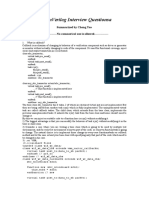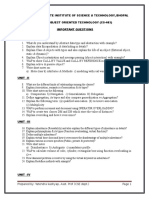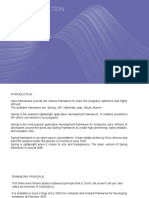System Verilog Interview Questions
Uploaded by
gagangc6566System Verilog Interview Questions
Uploaded by
gagangc6566Tips And Interview Questions | System Verilog
1 of 3
Home
System Verilog
Interview Questions SV
MAIN MENU
Home
System Verilog
- Constructs
- SV Classes
- Functional Coverage
SV
- Examples
- Tools
- Links
- Books
- Interview
Questions SV
-- What is callback
-- What is factory
pattern
-- Logic Reg wire
-- Need Clocking
Block
-- Ways to avoid
race
-- Coverage
Questions
-- OOP
-- Need of virtual
interface
-- abstract class
-- Part 1
-- Part 2
Verilog
Methodologies
Open Vera
Digital Concepts
Verification Basics
Protocols
Scripting
Articles
Videos
Interview Questions
Computer Architechture
C and C++
BLOG/ARTICLE
AsicGuru Blog
Tags Cloud
ADS
USEFULL SITES
Know Your IP/Location
Local Information India
Buy Car/Inverter Batteries
Real Estate India
Sports Accessories India
http://www.asicguru.com/system-verilog/interview-questions/10/
Tips and Interview Questions
Share This Articale:
LOGIN/REGISTER
Like
Tweet
System Verilog Interview Questions
Register
Sign In
Login with :gmail-yahoo-twitter-facebook
|
In this section you will find the common interview questions asked in system verilog related interview.
Please go below to see the pages with answers or click on the links on the left hand side. You can find
answers to all the below questions by Subash Nayak here : http://learn-systemverilog.blogspot.com
BOOKMARK
Here is my take on these questions with inputs from various sources.
1. What is callback ?
2. What is factory pattern ?
3. Explain the difference between data types logic and reg and wire
4. What is the need of clocking blocks ?
5. What are the ways to avoid race condition between testbench and RTL using SystemVerilog?
6. Explain Event regions in SV.
7. What are the types of coverages available in SV ?
8. What is OOPS?
9. What is inheritance and polymorphism?
10. What is the need of virtual interfaces ?
11. Explain about the virtual task and methods .
12. What is the use of the abstract class?
13. What is the difference between mailbox and queue?
14. What data structure you used to build scoreboard
15. What are the advantages of linkedlist over the queue ?
16. How parallel case and full cases problems are avoided in SV
17. What is the difference between pure function and cordinary function ?
18. What is the difference between $random and $urandom?
19. What is scope randomization
20. List the predefined randomization methods.
21. What is the dfference between always_combo and always@(*)?
22. What is the use of packagess?
23. What is the use of $cast?
24. How to call the task which is defined in parent object into derived class ?
25. What is the difference between rand and randc?
26. What is $root?
27. What is $unit?
28. What are bi-directional constraints?
29. What is solve...before constraint ?
30. Without using randomize method or rand,generate an array of unique values?
31. Explain about pass by ref and pass by value?
32. What is the difference between bit[7:0] sig_1; and byte sig_2;
33. What is the difference between program block and module ?
34. What is final block ?
35. How to implement always block logic in program block ?
36. What is the difference between fork/joins, fork/join_none fork/join_any ?
37. What is the use of modports ?
38. Write a clock generator without using always block.
39. What is forward referencing and how to avoid this problem?
40. What is circular dependency and how to avoid this problem ?
41. What is cross coverage ?
42. Describe the difference between Code Coverage and Functional Coverage Which is more important
and Why we need them
43. How to kill a process in fork/join?
44. Difference between Associative array and Dynamic array ?
45. Difference b/w Procedural and Concarent Assertions?
46. What are the advantages of SystemVerilog DPI?
47. How to randomize dynamic arrays of objects?
48. What is randsequence and what is its use?
49. What is bin?
50. Why always block is not allowed in program block?
51. Which is best to use to model transaction? Struct or class ?
52. How SV is more random stable then Verilog?
53. Difference between assert and expect statements?
54. How to add a new processs with out disturbing the random number generator state ?
55. What is the need of alias in SV?
56. What is the need to implement explicitly a copy() method inside a transaction , when we can simple
assign one object to other ?
57. How different is the implementation of a struct and union in SV.
58. What is "this"?
59. What is tagged union ?
ADS
Asicguru
Like
575 people like Asicguru
Facebook social plugin
21-05-2015 12:49
Tips And Interview Questions | System Verilog
2 of 3
http://www.asicguru.com/system-verilog/interview-questions/10/
60. What is "scope resolution operator"?
61. What is the difference between Verilog Parameterized Macros and SystemVerilog Parameterized
Macros?
62. What is the difference between
view source
print?
1.logic data_1;
2.var logic data_2;
3.wire logic data_3j;
4.bit data_4;
5.var bit data_5;
63. What is the difference between bits and logic?
64. Write a Statemechine in SV styles.
65. What is the difference between $rose and posedge?
66. What is advantage of program block over clockcblock w.r.t race condition?
67. How to avoid the race condition between programblock ?
68. What is the difference between assumes and assert?
69. What is coverage driven verification?
70. What is layered architecture ?
71. What are the simulation phases in your verification environment?
72. How to pick a element which is in queue from random index?
73. What data structure is used to store data in your environment and why ?
74. What is casting? Explain about the various types of casting available in SV.
75. How to import all the items declared inside a package ?
76. Explain how the timescale unit and precision are taken when a module does not have any
timescalerdeclaration in RTL?
77. What is streaming operator and what is its use?
78. What are void functions ?
79. How to make sure that a function argument passed has ref is not changed by the function?
80. What is the use of "extern"?
81. What is the difference between initial block and final block?
82. How to check weather a handles is holding object or not ?
83. How to disable multiple threads which are spawned by fork...join
The list of interview questions is taken from this link : http://www.edaboard.com/ftopic315416.html. I
will try to answer these questions one by one. If you know the answers of any questions please leave the
comment below
Index :
-- What is callback : Callback Concept
-- What is factory pattern : Factory Patten Concept
-- Logic Reg wire : Difference between logic, wire, reg
-- Need Clocking Block : What is the need of clocking blocks ?
-- Ways to avoid race : What are the ways to avoid race condition between testbench and RTL using SystemVerilog
-- Coverage Questions : What are the types of coverages available in SV explain
-- OOP : oop concepts
-- Need of virtual interface : What is the need of virtual interfaces ?
-- abstract class : What is the use of the abstract class?
-- Part 1 :
-- Part 2 :
Posted By : Web Development Surrey - Dec. 22, 2009, 5:51 a.m.
Interesting, These are some really helpful questions... Keep up the good work
Posted By : Subash - Feb. 17, 2010, 12:25 p.m.
This is rather a direct copy from here. :) http://learn-systemverilog.blogspot.com/2009/08/system-verilog-interviewquestions.html
Posted By : Pavithra Gokhale - Feb. 24, 2010, 7:57 a.m.
Really nice website..its very useful for beginners..i found it interesting.. thanx a lot Asic Guru:)
Posted By : jigar - Aug. 23, 2010, 4:11 a.m.
Q13- What is the difference between mailbox and queue? As Per http://verificationwithjigar.blogspot.com/2010/04
/sv-question-difference-between-mailbox.html Difference between mailbox and semaphore is very standard question
asked in System Verilog interview,Some times it is asked indirectly. Mailobox,Semaphore can pass the object or
information(variable).For example, there are multiple driver looking to drive same interface(lets call interface A). If
Verifciation environemtn uses Mailbox and provides packet to multiple driver,all of them is allowed access to packet and
henace all can drive the interface A. This will create multiple driver on same interface. In order to avoid this semaphore
21-05-2015 12:49
Tips And Interview Questions | System Verilog
3 of 3
http://www.asicguru.com/system-verilog/interview-questions/10/
can be used which ensures that once driver X has access to object only driver X will be able to drive interface A. driver Y
will have to wait till driver X returns the key so this will avoid multiple driver driving same interface
21-05-2015 12:49
You might also like
- Interview Questions On SVA For Formal VerificationNo ratings yetInterview Questions On SVA For Formal Verification2 pages
- I Didn't Know Constraints Could Do That!: John Dickol Samsung Austin R&D CenterNo ratings yetI Didn't Know Constraints Could Do That!: John Dickol Samsung Austin R&D Center41 pages
- Uvm Sequence details-Verification-SystemVerilogNo ratings yetUvm Sequence details-Verification-SystemVerilog23 pages
- Interview Questions For System Verilog: 1. What Is Clocking Block?100% (2)Interview Questions For System Verilog: 1. What Is Clocking Block?11 pages
- Interviews Question On Coverage in System Verilog - Hardware Design and VerificationNo ratings yetInterviews Question On Coverage in System Verilog - Hardware Design and Verification5 pages
- System Verilog: Question 1. What Is Callback ?100% (2)System Verilog: Question 1. What Is Callback ?15 pages
- SystemVerilog - FAQ - SystemVerilog Faq - PDF100% (1)SystemVerilog - FAQ - SystemVerilog Faq - PDF8 pages
- UVM Interview Questions Part 2 1705926241No ratings yetUVM Interview Questions Part 2 170592624123 pages
- SystemVerilog Interview Questions PART-3No ratings yetSystemVerilog Interview Questions PART-314 pages
- Advanced UVM: Architecting A UVM Testbench100% (2)Advanced UVM: Architecting A UVM Testbench20 pages
- Implement Randc Function Using Rand in System Verilog ?100% (1)Implement Randc Function Using Rand in System Verilog ?22 pages
- SystemVerilog Interview Questions PART-1No ratings yetSystemVerilog Interview Questions PART-117 pages
- Systemverilog Q&A: Normal Inline Assertion ExampleNo ratings yetSystemverilog Q&A: Normal Inline Assertion Example10 pages
- Solving Complex Users' Assertions: by Ben CohenNo ratings yetSolving Complex Users' Assertions: by Ben Cohen8 pages
- AMBA AHB AXI Interview Questions - Verification Guide75% (4)AMBA AHB AXI Interview Questions - Verification Guide2 pages
- Uvm Interview Questions and Answers PDF - Google Search0% (4)Uvm Interview Questions and Answers PDF - Google Search2 pages
- Uvm Interview Questions and Answers PDF - Google Search0% (4)Uvm Interview Questions and Answers PDF - Google Search2 pages
- Create A PDF File: Exercise 1 and Exercise 2 Produce The Same Result. Choose The One That Works Best For YouNo ratings yetCreate A PDF File: Exercise 1 and Exercise 2 Produce The Same Result. Choose The One That Works Best For You6 pages
- (Ebook) Learning Python Design Patterns by Chetan Giridhar ISBN 9781785888038, 178588803X - Quickly download the ebook in PDF format for unlimited reading100% (1)(Ebook) Learning Python Design Patterns by Chetan Giridhar ISBN 9781785888038, 178588803X - Quickly download the ebook in PDF format for unlimited reading57 pages
- System Landscape Directory Except WorkingNo ratings yetSystem Landscape Directory Except Working24 pages
- A Multi-Agent Architecture For Electronic PaymentNo ratings yetA Multi-Agent Architecture For Electronic Payment39 pages
- (FREE PDF Sample) Effective Python 90 Specific Ways To Write Better Python 2nd Edition Brett Slatkin Ebooks100% (3)(FREE PDF Sample) Effective Python 90 Specific Ways To Write Better Python 2nd Edition Brett Slatkin Ebooks62 pages
- (FREE PDF Sample) Python Crash Course 3rd Edition Eric Matthes EbooksNo ratings yet(FREE PDF Sample) Python Crash Course 3rd Edition Eric Matthes Ebooks49 pages
- Software Evolution: Machine Language Assembly Language Procedure Programming Object Oriented Programming (OOP)No ratings yetSoftware Evolution: Machine Language Assembly Language Procedure Programming Object Oriented Programming (OOP)17 pages
- Lecture07 - Components of Android ApplicationNo ratings yetLecture07 - Components of Android Application16 pages
- Answer : Find Missing Element in List of ArrayNo ratings yetAnswer : Find Missing Element in List of Array3 pages
- Name: Ayman Eathysham: Chocolate Room Billing SystemNo ratings yetName: Ayman Eathysham: Chocolate Room Billing System45 pages
- Cs - Students Profile Management SystemNo ratings yetCs - Students Profile Management System50 pages
- Assignment 1 Front Sheet: Qualification BTEC Level 5 HND Diploma in Computing Unit Number and Title Submission DateNo ratings yetAssignment 1 Front Sheet: Qualification BTEC Level 5 HND Diploma in Computing Unit Number and Title Submission Date8 pages





























































































